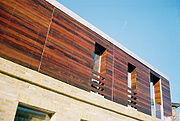
Palmwood
Encyclopedia
_in_klaten,_java.jpg)
Hardwood
Hardwood is wood from angiosperm trees . It may also be used for those trees themselves: these are usually broad-leaved; in temperate and boreal latitudes they are mostly deciduous, but in tropics and subtropics mostly evergreen.Hardwood contrasts with softwood...
-substitute from coconut
Coconut
The coconut palm, Cocos nucifera, is a member of the family Arecaceae . It is the only accepted species in the genus Cocos. The term coconut can refer to the entire coconut palm, the seed, or the fruit, which is not a botanical nut. The spelling cocoanut is an old-fashioned form of the word...
palm trees. It is referred to in the Philippines
Philippines
The Philippines , officially known as the Republic of the Philippines , is a country in Southeast Asia in the western Pacific Ocean. To its north across the Luzon Strait lies Taiwan. West across the South China Sea sits Vietnam...
as Coconut Lumber, or Coco Lumber. It is a new timber resource that comes from plantation crops and offers an alternative to rainforest timber.
Background
Coconut timber comes from farmed plantations of old coconut palms. The coconut palm was planted as a crop in large plantations throughout the tropics in the early half of the 20th century in order to harvest the coconut fruit. The tree bears fruit until approximately 70 years of age, at which point it is considered to have reached the end of its economic life and is felled to make way for future crops. Each year, several million palms are felled throughout the tropics. Traditionally, the trunks have been wasted by-products from this process.Only in very recent years have people begun to explore the potential commercial uses for this vast, alternative supply of timber. This led to the commercial launch of coconut timber in a range of different products, from flooring to posts to furniture. With these products performing at equal to or even better than conventional hardwoods, coconut timber represents a viable substitute for endangered hardwoods from an ecologically-sound source.
The pioneering work on coconut timber was conducted by Australian company Pacific Green
Pacific Green
Pacific Green Industries Limited is a Fijian manufacturer of furniture and architectural products. It is most recognised for its Pacific Green brand furniture and its development of Palmwood, a sustainable substitute for tropical hardwood. Pacific Green is distributed...
, which advised the 1997 United Nations Food and Agriculture Organization
Food and Agriculture Organization
The Food and Agriculture Organization of the United Nations is a specialised agency of the United Nations that leads international efforts to defeat hunger. Serving both developed and developing countries, FAO acts as a neutral forum where all nations meet as equals to negotiate agreements and...
study into Coconut Palm Stems.
Characteristics
Its wood is reminiscent in appearance to mahogany; however, coconut timber has a much more fibrous grain than mahogany and lacks the same level of iridescents. Colour tones and hues range from golden to near ebony, with dark brown flecks. There are three basic colour divisions relating to the timber's density: dark brown tones (high density); medium brown tones (medium density); and light golden tones (low density).Coconut trees have no annual growth rings, rays, heartwood or branches, meaning that coconut timber is free from knots and other such imperfections.
Properties
The coconut palm is a monocotyledonMonocotyledon
Monocotyledons, also known as monocots, are one of two major groups of flowering plants that are traditionally recognized, the other being dicotyledons, or dicots. Monocot seedlings typically have one cotyledon , in contrast to the two cotyledons typical of dicots...
. It has a smooth, slender stem that grows to a height of about 25 metres and with an average diameter of 300mm. The hardest, densest part of the wood is found on the outer perimeter of the trunk, which gives the tree its strength, while the wood’s high silica content gives the tree elasticity. Towards the centre of the trunk, the wood gets less hard.
Coconut timber is classified according to three degrees of density:
- High-density timber (dermal) – hard: 600-900kg/m³
- Medium-density timber (sub-dermal) – medium/hard: 400-600kg/m³
- Low-density timber (core) – soft/medium: 200-400kg/m³
Janka ball hardness test:-
- Coconut = 112,5 - 154,7 kgf/cm2 (1600 – 2200 psi) dependent on which figures you look at
- Oak between 70,3 - 84,4 kgf/cm2 (1000 – 1200 psi) dependent on type of oak.
- Douglas-fir = 35,9 kgf/cm2 (510 psi)


